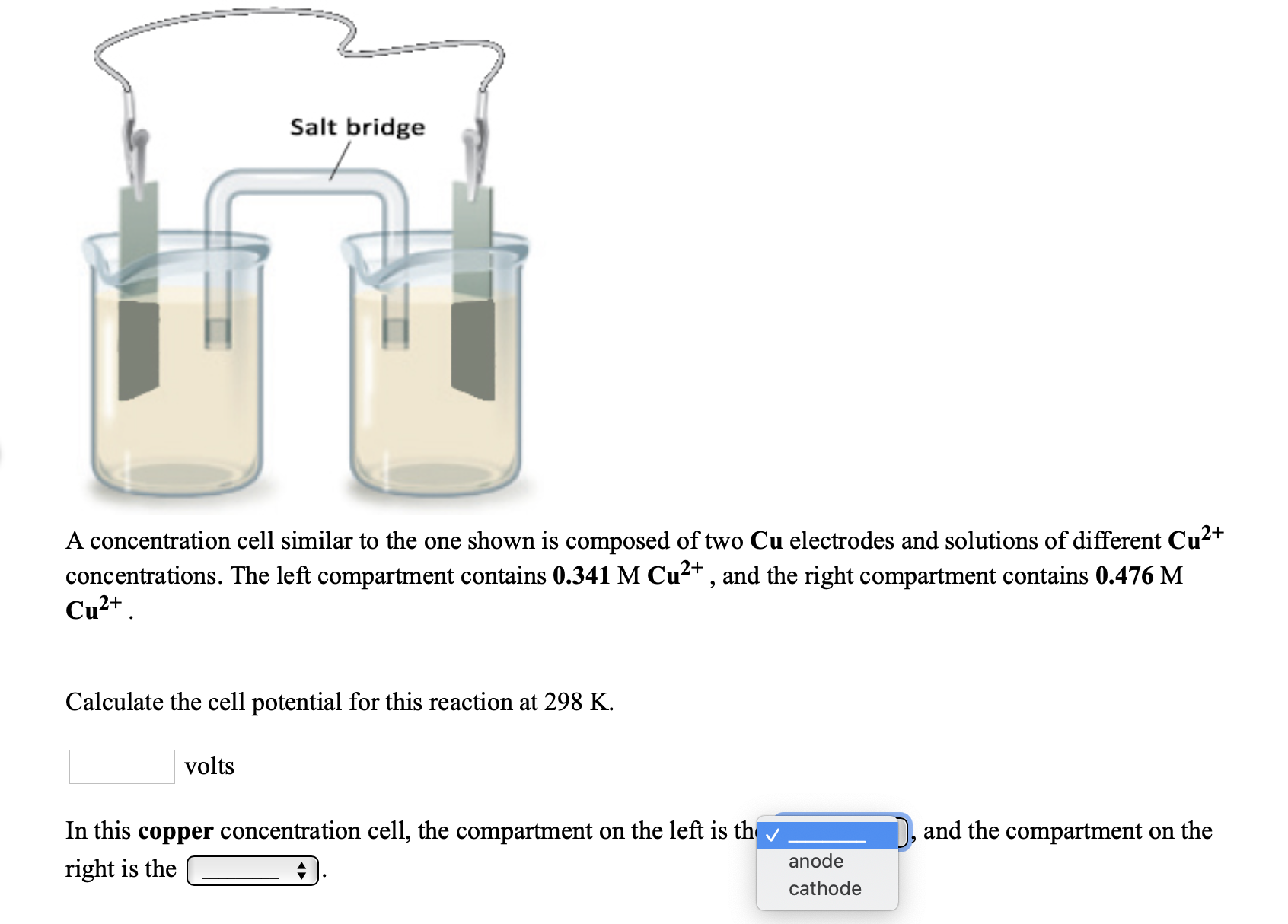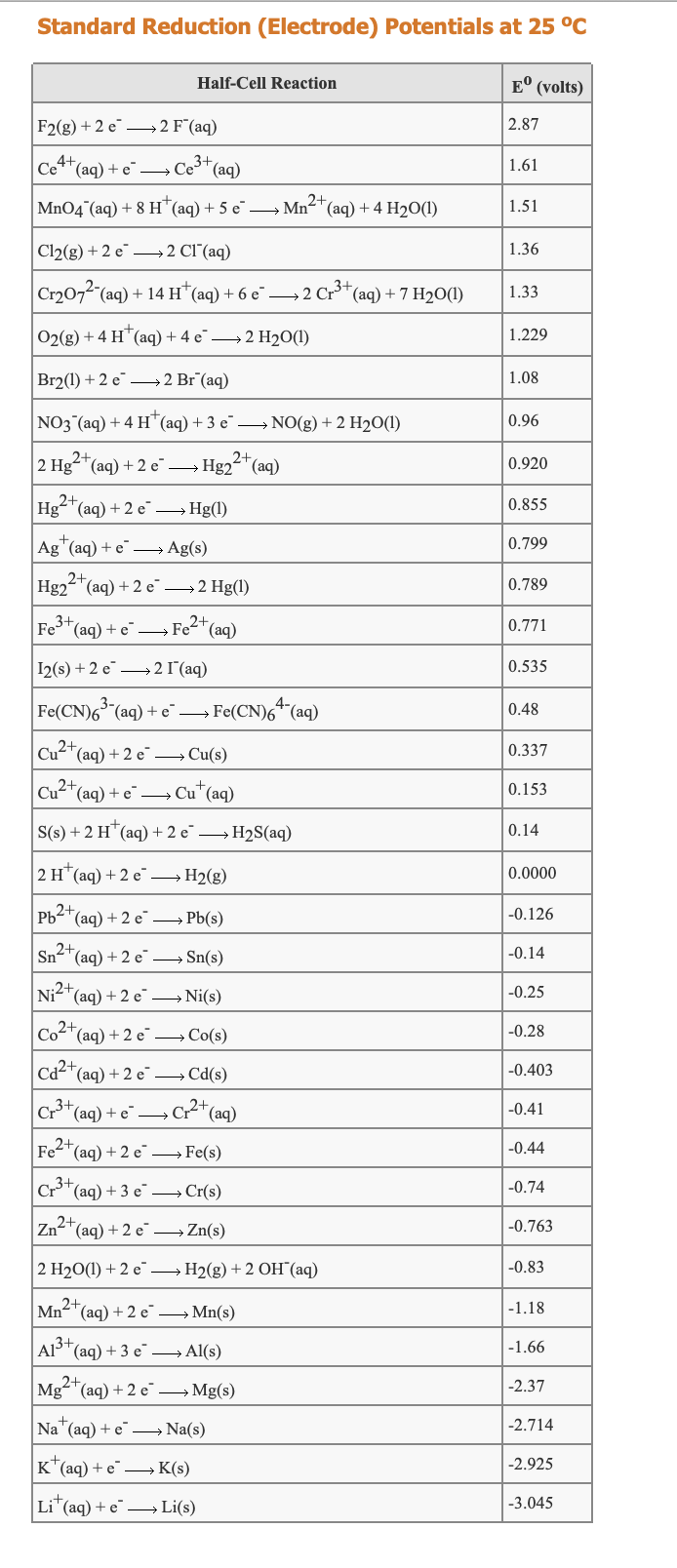Salt bridge A concentration cell similar to the one shown is composed of two Cu electrodes and solutions of different Cu²+ concentrations. The left compartment contains 0.341 M Cu2+ , and the right compartment contains 0.476 M Cu²+. Calculate the cell potential for this reaction at 298 K. volts In this copper concentration cell, the compartment on the left is the and the compartment on the anode right is the cathode Standard Reduction (Electrode) Potentials at 25 °C Half-Cell Reaction E° (volts) F2(g) + 2 e→2 F(aq) 2.87 Ce4*(aq) + e –→ Ce"(aq) 3+ 1.61 2+ MnO4 (aq) + 8 H"(aq) + 5 e¯ –→ Mn-T(aq) + 4 H2O(1) 1.51 Cl2(g) + 2 e' —2 СГ (aq) 1.36 Cr2072"(aq) + 14 H*(aq) + 6 e¯ →2 Cr"(aq) + 7 H2O(1) 1.33 O2(g) + 4 H*(aq) + 4 e→2 H2O(1) 1.229 Br2(1) + 2 e¯ –→2 Br¯(aq) 1.08 NO3 (aq) + 4 H"(aq) +3 e¯ –→ NO(g) + 2 H2O(1) 0.96 2 Hg-*(aq) + 2 e¯ → Hg22 (aq) 0.920 Hg-"(aq) + 2 e →Hg(1) 0.855 Ag"(aq) + e¯ – Ag(s) 0.799 2+, Hg2"(aq) + 2 e¯ →2 Hg(1) 0.789 Fe*(aq) + e → Fe2*(aq) 0.771 I2(s) + 2 e → 2 1 (aq) 0.535 Fe(CN)6° (aq) + e→ Fe(CN)64 (aq) 0.48 Cu2*(aq) + 2 e → Cu(s) 0.337 Cu2*(aq) + e" – Cu"(aq) 0.153 S(s) + 2 H*(aq) + 2 e → H2S(aq) 0.14 2 H*(aq) + 2 e → H2(g) 0.0000 Pb2*(aq) + 2 e → Pb(s) -0.126 Sn-"(aq) + 2 e¯ → Sn(s) „2+ -0.14 Ni2+(ag) + 2 e →Ni(s) -0.25 Co2+(ag) + 2 e →Co(s) -0.28 Cd2*(aq) + 2 e →Cd(s) -0.403 Cr3+ C* (aq) (aq) + e -0.41 Fe2*(aq) + 2 e →Fe(s) -0.44 Cr3+ (aq) + 3 e → Cr(s) -0.74 Zn2*(aq) + 2 e →Zn(s) -0.763 2 H20(1) + 2 e → H2(g) + 2 OH (aq) -0.83 Mn-"(aq) + 2 e¯ → Mn(s) 2+ -1.18 Als*(aq) + 3 e → Al(s) -1.66 2+ Mg"(aq) + 2 e →Mg(s) -2.37 Na"(aq) + e –→ Na(s) -2.714 K(aq) + e→ K(s) -2.925 Li*(aq) + e Li(s) -3.045
Salt bridge A concentration cell similar to the one shown is composed of two Cu electrodes and solutions of different Cu²+ concentrations. The left compartment contains 0.341 M Cu2+ , and the right compartment contains 0.476 M Cu²+. Calculate the cell potential for this reaction at 298 K. volts In this copper concentration cell, the compartment on the left is the and the compartment on the anode right is the cathode Standard Reduction (Electrode) Potentials at 25 °C Half-Cell Reaction E° (volts) F2(g) + 2 e→2 F(aq) 2.87 Ce4*(aq) + e –→ Ce"(aq) 3+ 1.61 2+ MnO4 (aq) + 8 H"(aq) + 5 e¯ –→ Mn-T(aq) + 4 H2O(1) 1.51 Cl2(g) + 2 e' —2 СГ (aq) 1.36 Cr2072"(aq) + 14 H*(aq) + 6 e¯ →2 Cr"(aq) + 7 H2O(1) 1.33 O2(g) + 4 H*(aq) + 4 e→2 H2O(1) 1.229 Br2(1) + 2 e¯ –→2 Br¯(aq) 1.08 NO3 (aq) + 4 H"(aq) +3 e¯ –→ NO(g) + 2 H2O(1) 0.96 2 Hg-*(aq) + 2 e¯ → Hg22 (aq) 0.920 Hg-"(aq) + 2 e →Hg(1) 0.855 Ag"(aq) + e¯ – Ag(s) 0.799 2+, Hg2"(aq) + 2 e¯ →2 Hg(1) 0.789 Fe*(aq) + e → Fe2*(aq) 0.771 I2(s) + 2 e → 2 1 (aq) 0.535 Fe(CN)6° (aq) + e→ Fe(CN)64 (aq) 0.48 Cu2*(aq) + 2 e → Cu(s) 0.337 Cu2*(aq) + e" – Cu"(aq) 0.153 S(s) + 2 H*(aq) + 2 e → H2S(aq) 0.14 2 H*(aq) + 2 e → H2(g) 0.0000 Pb2*(aq) + 2 e → Pb(s) -0.126 Sn-"(aq) + 2 e¯ → Sn(s) „2+ -0.14 Ni2+(ag) + 2 e →Ni(s) -0.25 Co2+(ag) + 2 e →Co(s) -0.28 Cd2*(aq) + 2 e →Cd(s) -0.403 Cr3+ C* (aq) (aq) + e -0.41 Fe2*(aq) + 2 e →Fe(s) -0.44 Cr3+ (aq) + 3 e → Cr(s) -0.74 Zn2*(aq) + 2 e →Zn(s) -0.763 2 H20(1) + 2 e → H2(g) + 2 OH (aq) -0.83 Mn-"(aq) + 2 e¯ → Mn(s) 2+ -1.18 Als*(aq) + 3 e → Al(s) -1.66 2+ Mg"(aq) + 2 e →Mg(s) -2.37 Na"(aq) + e –→ Na(s) -2.714 K(aq) + e→ K(s) -2.925 Li*(aq) + e Li(s) -3.045
Chapter18: Introduction To Electrochemistry
Section: Chapter Questions
Problem 18.18QAP
Related questions
Question
100%

Transcribed Image Text:Salt bridge
A concentration cell similar to the one shown is composed of two Cu electrodes and solutions of different Cu²+
concentrations. The left compartment contains 0.341 M Cu2+ , and the right compartment contains 0.476 M
Cu²+.
Calculate the cell potential for this reaction at 298 K.
volts
In this copper concentration cell, the compartment on the left is the
and the compartment on the
anode
right is the
cathode

Transcribed Image Text:Standard Reduction (Electrode) Potentials at 25 °C
Half-Cell Reaction
E° (volts)
F2(g) + 2 e→2 F(aq)
2.87
Ce4*(aq) + e –→ Ce"(aq)
3+
1.61
2+
MnO4 (aq) + 8 H"(aq) + 5 e¯ –→ Mn-T(aq) + 4 H2O(1)
1.51
Cl2(g) + 2 e' —2 СГ (aq)
1.36
Cr2072"(aq) + 14 H*(aq) + 6 e¯
→2 Cr"(aq) + 7 H2O(1)
1.33
O2(g) + 4 H*(aq) + 4 e→2 H2O(1)
1.229
Br2(1) + 2 e¯ –→2 Br¯(aq)
1.08
NO3 (aq) + 4 H"(aq) +3 e¯ –→ NO(g) + 2 H2O(1)
0.96
2 Hg-*(aq) + 2 e¯ →
Hg22 (aq)
0.920
Hg-"(aq) + 2 e →Hg(1)
0.855
Ag"(aq) + e¯ – Ag(s)
0.799
2+,
Hg2"(aq) + 2 e¯ →2 Hg(1)
0.789
Fe*(aq) + e →
Fe2*(aq)
0.771
I2(s) + 2 e → 2 1 (aq)
0.535
Fe(CN)6° (aq) + e→ Fe(CN)64 (aq)
0.48
Cu2*(aq) + 2 e → Cu(s)
0.337
Cu2*(aq) + e" – Cu"(aq)
0.153
S(s) + 2 H*(aq) + 2 e → H2S(aq)
0.14
2 H*(aq) + 2 e → H2(g)
0.0000
Pb2*(aq) + 2 e → Pb(s)
-0.126
Sn-"(aq) + 2 e¯ → Sn(s)
„2+
-0.14
Ni2+(ag) + 2 e →Ni(s)
-0.25
Co2+(ag) + 2 e →Co(s)
-0.28
Cd2*(aq) + 2 e →Cd(s)
-0.403
Cr3+
C* (aq)
(aq) + e
-0.41
Fe2*(aq) + 2 e →Fe(s)
-0.44
Cr3+
(aq) + 3 e → Cr(s)
-0.74
Zn2*(aq) + 2 e →Zn(s)
-0.763
2 H20(1) + 2 e → H2(g) + 2 OH (aq)
-0.83
Mn-"(aq) + 2 e¯ → Mn(s)
2+
-1.18
Als*(aq) + 3 e → Al(s)
-1.66
2+
Mg"(aq) + 2 e →Mg(s)
-2.37
Na"(aq) + e –→ Na(s)
-2.714
K(aq) + e→ K(s)
-2.925
Li*(aq) + e Li(s)
-3.045
Expert Solution
This question has been solved!
Explore an expertly crafted, step-by-step solution for a thorough understanding of key concepts.
This is a popular solution!
Trending now
This is a popular solution!
Step by step
Solved in 5 steps with 5 images

Recommended textbooks for you


Principles of Modern Chemistry
Chemistry
ISBN:
9781305079113
Author:
David W. Oxtoby, H. Pat Gillis, Laurie J. Butler
Publisher:
Cengage Learning



Principles of Modern Chemistry
Chemistry
ISBN:
9781305079113
Author:
David W. Oxtoby, H. Pat Gillis, Laurie J. Butler
Publisher:
Cengage Learning


Chemistry
Chemistry
ISBN:
9781305957404
Author:
Steven S. Zumdahl, Susan A. Zumdahl, Donald J. DeCoste
Publisher:
Cengage Learning

Chemistry: An Atoms First Approach
Chemistry
ISBN:
9781305079243
Author:
Steven S. Zumdahl, Susan A. Zumdahl
Publisher:
Cengage Learning

General Chemistry - Standalone book (MindTap Cour…
Chemistry
ISBN:
9781305580343
Author:
Steven D. Gammon, Ebbing, Darrell Ebbing, Steven D., Darrell; Gammon, Darrell Ebbing; Steven D. Gammon, Darrell D.; Gammon, Ebbing; Steven D. Gammon; Darrell
Publisher:
Cengage Learning